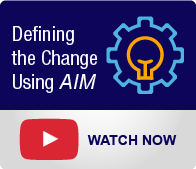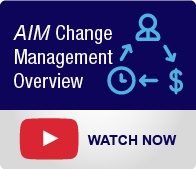In today’s business world, organizations are constantly trying to get ahead by using the most advanced and up-to-date technology. Billions of dollars a year are being spent on new CRM’s, ERP’s and other technological advances. But are these companies truly getting their money’s worth? 
Unfortunately, for as much money that is going out the door on these sophisticated new systems, Return on Investment is just not a guarantee. While many senior executives tend to blame the systems themselves, as Change Management experts, we know that new technology in and of itself doesn't bring value. Technological integrity is rarely the source of the problem. It’s usually the human and cultural aspects of implementation that cause sub-optimized results.
The truth of the matter is that new technology must be adopted to full functionality in order to bring value and ROI to an organization. While this may seem obvious, we’ve seen many organizations pay surprisingly little attention to measuring whether the business case for the investment was actually realized.
5 Common Mistakes
So, what’s going wrong in these organizations? Here’s our list of the top 5 mistakes commonly made during a new system roll out, and a few lessons learned.
Mistake #1: The New System is Installed Rather than Implemented
All too often, everyone thinks a project ends once the system officially gets to “go live”. The lights go on. The  system is up and running. We are done!! Right!?! Wrong! This is what we define as a successful “installation”. Yes, successful software installation is critical, but it’s definitely not the finish line.
system is up and running. We are done!! Right!?! Wrong! This is what we define as a successful “installation”. Yes, successful software installation is critical, but it’s definitely not the finish line.
Lesson Learned: Installation Does Not Equal Implementation! Installation of a new technology is defined as the “go live” or “cut over” date. Successful implementation is when the project is on time, on budget, all of the technical objectives have been met AND all of the business and human objectives have been met as well. Achieving "implementation" during a technology upgrade is the "golden ring" of user adoption and value realization.
Mistake #2: Ignoring the Human Factor
Unsuccessful or sub-optimized technology implementations are usually the result of companies failing to invest and prepare for the human elements of these implementations. Companies often mistakenly regard these  implementations as a purely technical issue with inadequate emphasis on the human elements leading to adoption. As a result, these companies have not achieved their business goals regarding cycle time, customer satisfaction, and cost reduction.
implementations as a purely technical issue with inadequate emphasis on the human elements leading to adoption. As a result, these companies have not achieved their business goals regarding cycle time, customer satisfaction, and cost reduction.
Lesson Learned: Identifying the human objectives (new behaviors) that enable the technology is a crucial first step. This begins with having a clear definition of the human objectives for the change. These are the "behaviors you seek to see”. If you aren't defining these behaviors up-front, you can't determine if the solution is adopted at the end!
Mistake #3: The IT Department Runs the Show
It’s typical for large-scale technology initiatives to be driven by the IT organization. However, the reality is that IT can’t be solely accountable for implementation success. Accountability and Sponsorship must be shared between IT and the business. Only the business leader can Sponsor the technology change in his/her organizational line of authority!
Lesson Learned: Remember to plan for the hand-off between IT and the business as part of the implementation plan. Reinforcing Sponsors at each level, in all impacted areas, must be clear about their role as a Sponsor, and then demonstrate personal commitment to the full use of the technology with their direct reports. To get full user adoption and overcome barriers to change, these Sponsors should be supported by a formal structure of local, respected individuals who already have the skills, or can be trained to be, effective Change Agents.
Mistake #4: Resistance Wins Out
“Most failures with ERP happen not because the software doesn’t work – it’s the acceptance of change that failed,” says Jeffrey Phillips, vice president of sales for Clarkston-Potomac, an IT consulting firm. In other words, people are resistant to changing the way that they do their jobs.
Lesson Learned: Human resistance to change is natural and inevitable. The resistance to system changes can be out in the open, or lurking below the surface. In either case, you can't ignore it; instead you need to find the sources, and manage it. One of the major purposes of any communication that goes out is to identify resistance through use of a feedback loop. Unfortunately, in many organizations past failed technology implementations have taught an important lesson, which is what we call the “kidney stone theory of change”—if we resist long enough, this too shall pass!
Mistake #5: Communication and Training Are the Only Forms of Change Management
While many organizations hope that a series of informational emails from top executives, cross-functional town-hall meetings, and training will overcome the barriers to adoption, these are rarely enough. Even involving subject matter experts from the business in the design of new processes and in requirements definition, while a positive step, is typically insufficient. 
Lesson Learned: To overcome the common barriers to a new technology adoption, a structured, purposeful Change Management process needs to be applied. IMA’s proprietary Accelerating Implementation Methodology (AIM) is focused on the human side of implementations. It identifies potential barriers to the change, enabling quick implementation with limited resources. In our experience, no organization will ever have the full complement of resources needed, so the only alternative is to find the right resources, train them, be clear about expectations, and reinforce performance. This in no way absolves leaders from doing what they need to do as Sponsors of the technology.
Mistakes are going to happen. To err is human. However, hopefully the lessons learned by others will help your organization not go down the same path. By using a change management methodology such as the Accelerating Implementation Methodology (AIM), your software/technology implementation can not only be successful; it can achieve the planned Return on your Investment.


